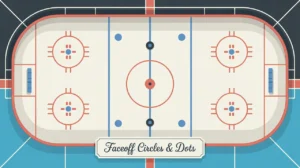Jim’s Intro to Locker Rooms
Hi folks, Jim here, the only commentator who was curious about how spacious lockers in an ice hockey locker room are; and then had to apologize to the rink staff and the fire brigade for wasting their time to get me out.
What are locker rooms?
Locker rooms are the off-ice headquarters where teams prepare, regroup, and reset between periods. Each team has its own locker room, equipped with benches, stalls, showers, whiteboards, and space for equipment, coaching, and team bonding. While fans never see the full story, the locker room is where line combinations are finalized, strategies are adjusted, equipment is repaired, and the emotional pulse of the team is set. It’s equal parts functional workspace and sacred team territory.
How do they work?
Locker rooms serve as the nerve center for preparation, strategy, and recovery.
- Pre-Game: Players arrive early to tape sticks, stretch, dress, and focus. Coaches deliver game plans and lineups. Equipment staff handles last-minute gear adjustments.
- Intermissions: Teams head back after each period to hydrate, rest, make tactical changes, and receive coaching. Trainers may treat injuries or fix equipment while players refocus mentally.
- Post-Game: Players cool down, debrief, and interact with media if required. Coaches address the team, often setting the tone for the next practice or game.
- Team Culture: Locker rooms are where rituals, music, speeches, and camaraderie happen. Captains and veterans often set the emotional tone here.
It’s not just a changing room. It’s where a team’s collective identity is reinforced every game.
How do you make good decisions with them?
Good locker room decisions revolve around focus, respect, and communication.
- Respect the Space: Keep it clean, respect teammates’ routines, and follow team rules.
- Manage Time: Arrive early enough to prepare without rushing. Use intermission time wisely for hydration, quick gear fixes, and mental reset.
- Communication: Listen to coaches, support teammates, and speak up when needed.
- Mindset: Treat the locker room as a preparation zone, not a lounge. Lock in mentally before stepping back onto the ice.
How do you master them?
Mastering the locker room is about routine and leadership. Experienced players build consistent pregame and intermission habits that sharpen focus and calm nerves. Teams develop rituals, like chants, stick taps, or speeches, that build energy. Captains and coaches lead by setting expectations for effort and attitude. When a locker room runs smoothly, it carries directly onto the ice.
What does it look like when done right?
A well-run locker room hums with quiet purpose before a game, adjusts quickly during intermissions, and bonds tightly afterward. Players know their routines, coaches deliver clear messages, and everyone leaves the room aligned. Gear is organized, chatter has intent, and the energy builds in waves rather than chaos.
Commentator’s Corner
Jim’s Take
I’ve stood outside locker rooms that sounded like libraries and others that sounded like rock concerts. The best ones strike that perfect balance between focus and fire.
Parent Tip
Help young players build pregame routines early. A good locker room habit, like taping sticks, stretching, or reviewing plays, teaches discipline and confidence.
Player Tip
Use the locker room to prepare, not distract. Find the routine that locks you in, respect your teammates’ space, and treat the room like your second home.
A Final Thought
Locker rooms may sit just off the ice, but they shape everything that happens on it. They’re where preparation meets purpose, and where individual players become a team.









